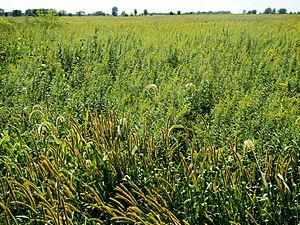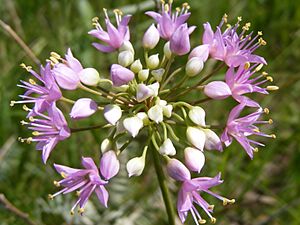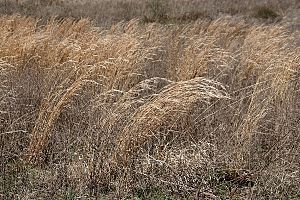Tallgrass prairie facts for kids

A tallgrass prairie is a special type of ecosystem found in central North America. It's a huge grassland where tall grasses grow, and fire is a natural and important part of its life. Long ago, these prairies covered much of the American Midwest and parts of Canada. They grew best in areas with rich soil and a good amount of rain each year.
To the west, where it was drier, you would find shortgrass prairies with smaller grasses.
Contents
How the Tallgrass Prairie Formed and Changed
About 10,000 years ago, as glaciers melted, they left behind the material that would become the prairie's soil. Over time, wind blew in fine dust called loess, and dead plants added rich organic matter. This created very deep, fertile topsoil.
Animals like bison, elk, and deer helped keep the soil healthy. Prairie dogs, which are like ground squirrels, dug tunnels. These tunnels helped air and water get deep into the soil.
For thousands of years, these grasslands covered a huge area, like a vast "Inland Sea." But between the 1800s and 1930s, most of it disappeared. Settlers turned the prairie into farmland.
Several things led to the prairie's decline:
- European cattle grazed differently than bison, harming the grasses.
- Most prairie dogs were removed.
- Plowing the land broke the deep roots of the tall grasses, stopping them from growing back.
- Draining the land for farming also changed the soil's water.
Today, only a tiny part of the original tallgrass prairie remains. You can find small pieces in old cemeteries, along highways, or in special restoration areas.
Life in the Tallgrass Prairie Ecosystem
As its name suggests, the most noticeable plants in a tallgrass prairie are the tall grasses. Some, like big bluestem and indiangrass, can grow 5 to 6 feet (1.5 to 2 meters) tall, and sometimes even taller!
But prairies aren't just grass. They also have many colorful flowering plants called forbs. These include lead plant, Prairie Rosinweed, and coneflowers.

The Importance of Fire
The tallgrass prairie needs prairie fires to survive and stay healthy. These fires, which can be started by lightning or by people, help the ecosystem. They burn away young trees and plants that don't belong, allowing the grasses and forbs to thrive. Native Americans used to set fires to help hunt bison and make travel easier.
When people tried to grow tallgrass prairies without fire, they didn't do well. But once controlled fires were used, the prairies started to grow back.
A true prairie has very few trees, usually less than 5-11% tree cover. If there are more trees (10-49% cover), it's called a savanna.
The soil in the North American tallgrass prairie was incredibly deep and fertile. After John Deere invented the steel plow, this rich soil became very important for farming. Today, over 99% of the original tallgrass prairie has been turned into farmland.
Where Tallgrass Prairies Still Exist
Some tallgrass prairies still survive in places that were hard to plow. These include:
- The rocky Flint Hills in Kansas.
- Parts of the Red River Valley in Manitoba and Minnesota.
- The Coteau des Prairies in South Dakota, Minnesota, and Iowa.
- The northern part of Oklahoma, where ranchers kept the tall grasses for grazing bison and cattle.
Protected Areas
Many groups are working to protect and restore these special grasslands:
- The Tallgrass Prairie Preserve in Oklahoma is a large area where bison have been brought back.
- The Tallgrass Prairie National Preserve in Kansas also works to keep this ecosystem natural.
- Other preserves include Midewin National Tallgrass Prairie in Illinois, Broken Kettle Preserve in Iowa, Konza Prairie in Kansas, and Prairie State Park in Missouri.
In Canada, most of Manitoba's tallgrass prairie was lost to farming. However, some smaller areas remain, like the Tallgrass Aspen Parkland. The Manitoba Tall Grass Prairie Preserve protects about 10,000 acres of prairie, aspen parkland, and wetlands.

In North Dakota, the Sheyenne National Grassland is the only National Grassland on the tallgrass prairie. There's also a small area of tallgrass prairie in Windsor, Ontario, Canada, protected by parks like Ojibway Park.
Bringing Back the Prairie: Restoration Efforts
People are working hard to bring back the tallgrass prairie.
- The Midewin National Tallgrass Prairie in Illinois, started in 1996, is one of the largest restoration areas in the United States.
- In Minnesota, the Glacial Ridge National Wildlife Refuge was created in 2004. It includes a preserved prairie area, and thousands of acres are being restored. Wetlands are being brought back, and native plants are being re-seeded.
See also
 In Spanish: Pradera de hierbas altas para niños
In Spanish: Pradera de hierbas altas para niños



